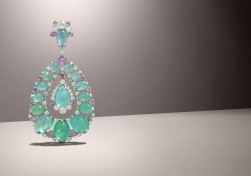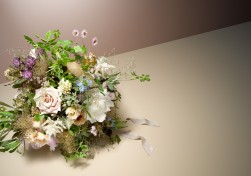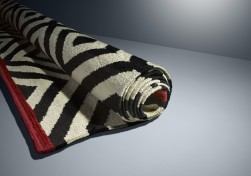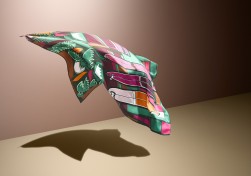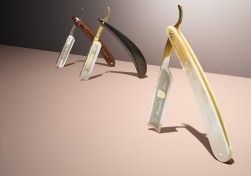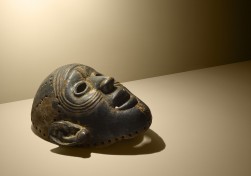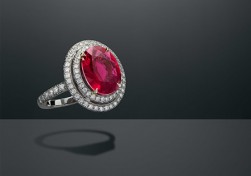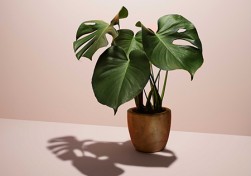Earrings – the bigger, danglier and more ornate the better – have been stealing the show on catwalks since the beginning of the year, when Flamenco-style tassels filled the glossies’ fashion pages. This season, if earrings don’t tickle the shoulder, they’re considered understated. Versace’s key-shaped earrings look like they could unlock a castle gate, Zadig & Voltaire’s chandeliers hang down to chest level, while Toga’s grapes are the chunkiest bunches you’d wish on your poor ears. It’s a refreshing change from the restrained minimalism that has kept ladies’ ears prim and proper for so long. Granted, what we see on the catwalk is not always what makes its way into daily life, but jewelers around the world have clearly taken note. Global jewelry brand David Morris, for example, has created a series of stunning couture pieces, combining red spinels, opals, pink pearls, and emeralds. A stand-out set (pictured) offsets Paraiba tourmaline, pink sapphire and round white diamond brilliants on 18ct white gold. Sitting just above the shoulder, they’re far from excessive – in the current climate – but by no means modest. davidmorris.com
Category Archive: 7 objects
Tea, we’re reliably informed, is the new wine. Sommeliers in fine dining establishments are serving cold-brewed tea in wineglasses and at two Michelin-starred New York restaurant Atera you can enjoy a “tea progression” comprising six different teas matched to an 18-course tasting menu. But this isn’t tea as we know it. Following the “craft” blueprint laid out by wine, beer and coffee, tea producers (and drinkers) are now paying much closer attention to the origin, terroir, harvesting and manufacturing techniques of their chosen brew. The humble teabag favored by most tea-drinkers might be quick and convenient, but it’s relatively insipid in terms of taste. Loose-leaf tea, meanwhile, offers a vastly superior depth and variety of flavor. And the health benefits aren’t bad either, with certain teas said to aid relaxation, allergies, aging, digestion, energy and weight loss. The other result of all this renewed interest in tea is that aficionados are now investing in beautiful teapots, like this one from iconic Danish design house, Kähler, and taking a Zen-like pleasure in the ritual of making a pot of tea. kahlerdesign.com
“This country is in the midst of a floral revolution,” writes Harper’s Bazaar editor-in-chief Deborah Needleman in The New York Times. “Flower arrangements have become wilder and stranger, incorporating all manner of seasonal flora plucked from the woods, the garden, the roadside and the vegetable patch.” And it’s not just in the US. Across the pond, it emerged that Prince Harry had foraged his wedding bouquet’s astilbes and sweet peas himself – a move that was not just touching but surprisingly on point. “Brides are moving away from bright, formal, ball-like bouquets in favor of wilder, more organic-looking styles,” says Hannah Antmann of Saint Floral, a floral design studio based a few miles from Windsor, where the royal wedding took place. “They want their flowers to look ethereal and whimsical, and they want them to look like they’ve been handpicked from local fields.” In this bouquet (pictured) Antmann has incorporated flowers in antique tones of powder blush, soft apricot and dusty pinks, while the foliage includes pistachio, preserved eucalyptus, foraged sycamore, dog rose and ivy vines. saintfloral.co.uk
Bamboo might well be the most versatile material on the planet. Today it is used in construction (its tensile strength is greater than that of mild steel), plywoods, plastics, biofuel, medicine, 3D-printing and even juice. Not only is it strong, lightweight, and even tasty, it’s also eco-friendly. Bamboo is the world’s fastest-growing plant – some species grow more than three feet per day. It flourishes in marginal land, requires little water, and can be harvested without killing the plant. On top of this, it converts up to four times more CO2 into oxygen than normal trees. Which is why bamboo silks, bamboo rayons and now Tencel (a sustainable cellulosic fiber also made from bamboo) are making their way onto the runways of fashion brands and into our homes. IKEA is committed to using the material in more of its products, while designers at The Conran Shop have been experimenting with bamboo for years. The brand’s exclusive kilim rugs (pictured), for example, are made from a blend of 80 per cent bamboo and 20 per cent cotton, giving them the luxurious feel of silk but enough durability to endure steady footfall. theconranshop.co.uk
The foulard has become this year’s must-have accessory. These printed silk scarves have come and gone over the years, but never before have so many women (and men) looked to them to add a pop of a color or a dash of glamour to their ensemble. But instead of the traditional knotted-under-the-chin style, today’s fashion cognoscenti are using them as belts, bows and bag straps, tying them imaginatively around their necks, waists and wrists. They really come into their own when you’re on vacation, evoking as they do the golden age of travel. In those days, silk “souvenir scarfs” were part of the vacation uniform, and if you didn’t leave wearing one; you’d almost certainly come home in one. Nowadays, leaving with one is de rigueur, ideally one by Hermès. The French fashion house’s scarves are timeless and quintessentially chic: whether it’s the classic equine-inspired designs of old, or this season’s more contemporary “Sea, Surf and Fun” prints (pictured) by Brazilian artist Filipe Jardim – guaranteed to give even the most understated of outfits a luxury lift. hermes.com
According to Forbes, barbering is America’s fastest-growing profession. Much like bricklaying, it isn’t threatened by the internet – in other words, you can’t get your hair cut online. So while stores around the world battle against e-commerce, landlords are welcoming barbers with open arms. Which is convenient, given men’s newfound penchant for taking care of themselves. The global market for male grooming is expected to be worth $60.7bn by 2020, with 80 per cent of products bought in stores. Many of the new wave of barbershops are taking their cues from the likes of Truefitt & Hill – established in 1805 – where gentlemen go for traditional cutthroat shaves, facials, manicures, shoe-shines and now their toiletries. It’s here that normally stoic fellows can be found gushing over the smell of a pomade as it’s massaged into their scalps. They’ll be informed that the pomade, hair tonic and bergamot beard oil are the shop’s own brand, and they will leave with a bag full of cosmetics – and possibly a straight razor. This is modern grooming, and you get no points for looking or smelling anything but your very best. truefittandhill.co.uk
Any regular visitor to the world’s leading contemporary art fairs will have noticed an increase in the amount of tribal art on display, specifically African tribal art. Unsurprisingly, this surge has corresponded with a rise in the price of high-end lots sold at the world’s big auction houses. In 2014, a very rare Senufo female statue carved by 19th-century Ivory Coast artist Master of Sinasso sold for $12m at Sotheby’s New York. Prior to that, the record was held by a Ngil mask of the West African Fang culture, which fetched $7.5m in Paris in 2006. “Tribal art has been in the same conversation as Cubism, Picasso, Braque and Modigliani for years now, so it’s no surprise people are buying bits for their art collections,” says Bryan Reeves, owner of Tribal Gathering London, which provided the mask pictured – made by a Malawian tribe, the Chewa. Regardless of your budget, there are certain qualities to look out for if you’re tempted to invest: age and rarity are important; pieces have to be made for traditional tribal use, not for commercial sale; and they also need to have great form, patina and expression. tribalatheringlondon.com
Although traditionally the ruby has been considered just one of the four great precious stones (alongside emeralds, diamonds and sapphires), in recent years it has taken a starring role in jewelry collections. According to the author Joanna Hardy, who spent three years researching a new book on the subject, the ruby’s rise to prominence has been driven primarily by scarcity. Where once fine rubies could be readily discovered in Burma, Thailand and Cambodia, today supplies are running out – which partly explains the record prices reached at auction, which have exceeded those of diamonds, per carat. Jewelers today are now having to look as far afield as Mozambique to find stones; and while many of these are not as big as elsewhere, they are 700 million years old (compared with Burma’s 50 million). Rubies come in a variety of colors, from vibrant pinks – such as the 4.3-carat Burmese stone from Boodles pictured here – and dark blood red to a glossy pomegranate shade, known in the trade as “pigeon’s blood”. And the ultimate ruby? “The Graff 8.62ct ruby, says Hardy. “It shines like a beacon even in low light – and stones of such fine quality are extremely rare. The Van Cleef & Arpels Peony Clip is also stunning: it’s as close to being perfect as a hand-crafted jewel can be.” boodles.com
Carrying a micro-bag is not a fashion to follow if you’re a woman who normally carries everything but the kitchen sink about with her. But this is a trend that even the most practical are swooning over because, well, this season’s bags – like the one pictured, from Tod’s – are just so adorable. Not only are the mini-, micro- and nano-bags about the size of play-bags that many of us might have carried about as girls, several have also been designed to look wonderfully playful, too, shaped like elephants, embroidered with bold fruit and flower emblems, and adorned with sparkles. In short, they’re fun. Not every fashion house has focused on frivolity, though. Many designers have created a must-have mini-bag that’s a scaled-down version of an old favorite, with all the functionality and proportions of its original. The Hermès Constance Micro Bag, for instance, has all the hallmarks of the larger model, with dual compartments, elegant hand-stitching and a palladium clasp – but at a fifth of its size. The Lady Dior, too, has spawned two miniature versions: one five inches wide, and the second six inches. Surprisingly, scaling down from a full-size bag is easy to get used to. Once you’ve redefined what counts as essentials (goodbye water bottle and notebook; hello credit card, lipstick, phone and keys), micro-bags are a weight off your shoulders – literally. They’re also a great way to get your hands on a designer bag, at a palatable price point. What’s there not to coo at? tods.com
Greenery has been a motif on the fashion catwalks for the past few years, but it’s only recently that fashionistas have started to bring real tropicalia indoors and to grow plants themselves. Why their sudden enthusiasm? Not only because plants enhance a modishly midcentury interior – especially that 1970s stalwart, the cheeseplant (pictured), or because city-dwellers now understand the ways plants can improve their health and environment, believes American gardening expert Tovah Martin. It’s a deeper reason: a need to be rooted. “Everyone yearns to play in the dirt, she says. “Besides, a houseplant is therapeutic. It gives you something to nurture.” One difference between these gardeners and their green-fingered grandparents, notes Michelle Slatalla in her blog Gardenista, is the type of plants they’re growing. While in the 1950s and ’60s it might have been a violet, in the 1970s a spider plant in a macramé hanger (currently enjoying a comeback), today’s indoor gardeners prefer architectural flora that requires very little care –cacti and succulents that create a cool Californian vibe; or the fiddle-leaf fig, which is currently the fashionable choice of hip boutiques from Marimekko in Finland to Céline in Europe. The key to creating the right look, captured on hashtags such as #urbanjungle, #monsteramonday or #plantgang? Pick the plant as you would a piece of furniture, says Slatalla, and then arrange in clusters. “The look you want is a living work of art.” conservatoryarchives.co.uk
